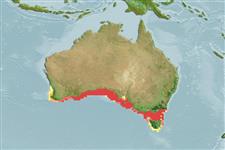>
Perciformes/Scorpaenoidei (Scorpionfishes) >
Neosebastidae (Gurnard scorpionfishes)
Etymology: Maxillicosta: Latin, maxilla = jaw + Latin, costa, -ae = rib or rib like parts (Ref. 45335); meridianus: Name from Latin 'meridianus' meaning southern, referring to the southern distribution..
More on authors: Motomura, Last & Gomon.
Environment: milieu / climate zone / depth range / distribution range
بوم شناسي
دريايي نزديك كف زي; تغييرات عمق 10 - 137 m (Ref. 57438). Tropical
Southeastern Indian Ocean: Australia.
Size / Weight / سن
Maturity: Lm ? range ? - ? cm
Max length : 7.9 cm SL جنس نر / بدون خواص جنسي; (Ref. 57438)
توصيف مختصر
ريخت شناسي | ريخت ستجي بوسيله انداره گيري
This species is characterized by the following: pectoral-fin rays 21-24 (22) ; scales in longitudinal series 47-51 (49); pored lateral-line scales 27-29 (28); scale rows between last pelvic-fin ray bases 3 or 4 (3); scales above lateral line 2 or 3 (3), below 12-14 (13); scales between sixth dorsal-fin spine base and lateral line 3-5 (4); scales between last dorsal-fin spine and lateral line 4 or 5 (5); scales above lateral line behind head usually with no strong median ridge; central portion of inner ridge on ventral mandibular surface at the inner edge of dentary or closer to inner edge than to central ridge, no short ridge between posterior
portions of inner and central ridges; spinous points 0-6 on anterior margin of nasal spine, number decreasing with growth, spinous points 5-15 on entire nasal spine; spinous points 5-13 on surface of preocular spine; spines or distinct ridges absent on lateral margin of occipital pit between tympanic spine and origin of parietal spine base; ossified scale behind front edge of occipital pit between tympanic spines absent; dorsal surface of occipital pit smooth, no spines; spinous points 2 (rarely 1 or 3) at tip of upper opercular spine; posterior margin of maxilla extending slightly beyond a vertical through posterior margin of pupil; snout length 7.9-9.6 (8.6)% SL, upper-jaw length 19.1-22.2 (20.3)% SL, first anal-fin spine length 11.6-14.4 (13.1)% SL, second anal-fin spine length 18.4-22.5 (20.5)% SL, third anal-fin spine length 13.4-16.2 (14.7)% SL, and caudal-peduncle depth 7.8-9.0 (8.6)% SL; body without reticulate color pattern; caudal fin of preserved specimens usually without distinct melanin (Ref. 57438).
Observed to bury itself completely in the sand during the day, but are fully exposed at night. Prefers deeper sand channels, away from rubble or seagrasses (Ref. 57438).
Life cycle and mating behavior
بلوغ | تولید مثل | تخم ریزی | تخم ها | Fecundity | توزاد ( لارو)
Motomura, H., P.R. Last and M.F. Gomon, 2006. A new species of the scorpionfish genus Maxillicosta from the Southeast coast of Australia, with a redescription of M. whitleyi (Scorpaeniformes: Neosebastidae). Copeia 2006(3):445-459. (Ref. 57438)
وضعيت در فهرست قرمز IUCN (Ref. 130435)
خطر برای انسان ها
Harmless
استفاده انسانی
اطلاعات بيشتر
اسامي عاممترادفسوخت و سازشکارچیانسم شناسي بوم زيستيتولید مثلبلوغتخم ریزیSpawning aggregationFecundityتخم هانمو تخم
Age/Sizeرشدطول - وزنطول - طولنوسانات طولیريخت ستجي بوسيله انداره گيريريخت شناسيتوزاد ( لارو)پويايي لارويبازسازیفراوانيBRUVS
مراجعآبزي پرورينمايه آبزي پرورينژادهاژنتيكElectrophoresesوارثبيماري هافرآوریNutrientsMass conversion
همكارانعکس هاStamps, Coins Misc.صداهاسيگواتراسرعتنوع شناگریمنطقه آبششيOtolithsمغزهابینایی
ابزارها
گزارش های ويژه
بارگيری XML
منابع اينترنتي
Estimates based on models
Preferred temperature (Ref.
123201): 14.3 - 18.2, mean 16.7 °C (based on 124 cells).
Phylogenetic diversity index (Ref.
82804): PD
50 = 0.5156 [Uniqueness, from 0.5 = low to 2.0 = high].
Bayesian length-weight: a=0.01000 (0.00244 - 0.04107), b=3.04 (2.81 - 3.27), in cm total length, based on all LWR estimates for this body shape (Ref.
93245).
Trophic level (Ref.
69278): 3.4 ±0.5 se; based on size and trophs of closest relatives
Fishing Vulnerability (Ref.
59153): Low vulnerability (10 of 100).
